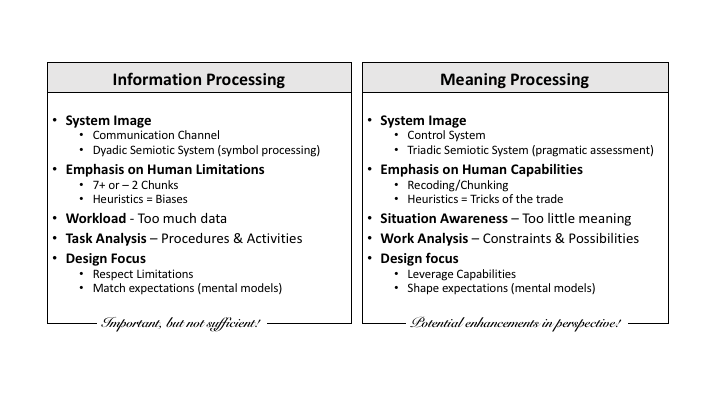This is the fourth in a series of entries to explore the differences between an Information Processing Approach to Human Factors and a Meaning Processing Approach to Cognitive Systems Engineering. The table below lists some contrasts between these two perspectives. This entry will focus on the third contrast in the table - the shift from a focus on 'workload' to a focus on 'situation awareness.'

The concept of information developed in this theory at first seems disappointing and bizarre - disappointing because it has nothing to do with meaning, and bizarre because it deals not with a single message but rather with the statistical character of a whole assemble of messages, bizarre also because in these statistical terms the two words information and uncertainty find themselves to be partners. Warren Weaver (1963, p. 27)
The construct of 'workload' is a natural focus for an approach that emphasizes describing and quantifying internal constraints of the human and that assumes that these constraints are independent of the particulars of any specific situation or work context. This fits well with the engineering perspective on quantifying information and for specifying the capacity of fixed information channels as developed by Shannon. However, the downside of this perspective is that in making the construct of workload independent of 'context,' it thus becomes independent of 'meaning' as suggested in the above quote from Warren Weaver.
Those interested in the impact of context on human cognition became dissatisfied with a framework that focused only on internal constraints (e.g., bandwidth, resources, modality) without consideration for how those constraints interacted with situations. Thus, the construct of Situation Awareness (SA) evolved as an alternative to workload. Unfortunately, many who have been steeped in the information processing tradition have framed SA in terms of internal constraints (e.g., treating levels of SA as components internal to the processing system).
However, others have taken the construct of SA as an opportunity to consider the dynamic couplings of humans and work domains (or situations). For them, the construct of SA reflects a need to 'situate' cognition within a work ecology and to consider how constraints in that ecology create demands and opportunities for cognitive systems. In this framework, it is assumed that cognitive systems can intelligently adapt to the constraints of situations - utilizing structure in situations to 'chunk' information and as the basis for smart heuristics that reduce the computational burden, allowing people to deal effectively with situations that would overwhelm the channel capacity of a system not tuned to these structural constraints (see aiming off example).

There is no question that humans have limited working memory capacity as suggested by the workload construct. However, CSE recognizes the ability of people to discover and use situated constraints (e.g., patterns) in ways that allow them to do complex work (e.g., play chess, pilot aircraft, drive in dense traffic, play a musical instrument) despite these internal constraints. It is this capacity to attune to structure associated with specific work domains that leads to expert performance.
The design implication of an approach that focuses on workload is to protect the system against human limitations (e.g., bottlenecks) by either distributing the work among multiple people or by replacing humans with automated systems with higher bandwidth. The key is to make sure that people are not overwhelmed by too much data!
The design implication of an approach that focuses on SA is to make the meaningful work domain constraints salient in order to facilitate attunement processes. This can be done through the design of interfaces or through training. The result is to heighten human engagement with the domain structure to facilitate skill and expertise. The key is to make sure that people are well-tuned to the meaningful aspects of work (e.g., constraints and patterns) that allow them to 'see' what needs to be done.

